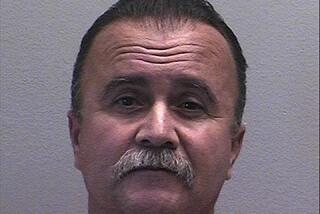Landlady’s Trial in Tenants’ Murders Begins : Crime: Sacramento woman preyed on ‘shadow people’ who could not fend for themselves, prosecutor says.
- Share via
MONTEREY — Dorothea Montalvo Puente, the Sacramento landlady accused of killing her boarders and burying them in the garden, preyed on “shadow people” who were unable to fend for themselves, a prosecutor charged Tuesday as her long-awaited murder trial began.
Puente, charged with killing nine people between 1982 and 1988, has been in jail for more than four years after the grisly discovery of seven bodies buried in the yard of her downtown Sacramento boarding house.
In opening arguments, Sacramento Deputy Dist. Atty. John O’Mara said Puente killed her victims so she could steal their government aid payments.
O’Mara told the jury that one of the victims was found buried in the yard with head, hands and lower legs cut off. All of the bodies contained traces of Dalmane, a prescription sleeping pill.
Puente’s trial was moved from Sacramento to Monterey because of extensive pretrial publicity. The prosecution is seeking the death penalty, and selection of the jury took more than two months. Opening arguments will continue through Thursday and the trial is expected to last six to 10 months.
The white-haired, 64-year-old Puente has admitted cashing the checks of the missing people but has denied killing anyone.
The defense is scheduled to open its case Wednesday. In an interview before the trial began, Kevin Clymo, one of her attorneys, said, “She didn’t do it. They’ve got it all wrong.”
The prosecution, Clymo maintained, cannot establish the cause of death for eight of the victims. The ninth, he argued, committed suicide.
“There are no eyewitnesses that say Dorothea buried bodies there,” he said. “There is no allegation there were accomplices involved. It requires a huge leap of nothing but pure faith.”
Wearing a black sweater over a multicolored dress, Puente sat calmly and wrote notes to her attorneys as O’Mara recounted aspects of the case in painstaking detail. O’Mara showed jurors a video of the exhumation and numerous photos of the bodies, but he spent little time attempting to tie Puente directly to the deaths.
The bodies were discovered in November, 1988, when an outreach worker began worrying about the whereabouts of a retarded, schizophrenic man named Alvaro (Bert) Montoya who had gone to live at Puente’s boarding house.
In fact, O’Mara said, police had been told seven months earlier that Puente was murdering people and burying their bodies in the garden. But investigators discounted the tip because it came from a heroin addict who was under arrest on other charges.
Dissatisfied with Puente’s explanation for Montoya’s disappearance, police began digging in her back yard. After the first body was discovered, Puente told police she wanted to visit her nephew and was given an escort through a gathering crowd of reporters and spectators, the prosecutor said.
She took a cab to a nearby bar and then another cab to the bus station in Stockton. She was arrested nearly a week later in Los Angeles when she was turned in by a man who recognized her from news photos. She had befriended him in a bar after learning he was living on disability payments.
Puente’s attorneys note that she called police when the first boarder in the case died in 1982, apparently of a prescription drug overdose. She now faces murder charges in that case.
Later, Clymo said, she did not notify police of the deaths of other boarders because she was on parole for an earlier conviction of drugging elderly people and cashing their disability and Social Security checks.
“She didn’t report these deaths because she was on parole,” Clymo said. “One of the conditions of her parole was that she not be working in contact with elderly or disabled folks.”
Seven of the murder charges are in connection with the bodies found in her yard. Another body was found in a remote area outside Sacramento.
O’Mara told the jury that Puente took advantage of people who had difficulty caring for themselves and were little noticed by the rest of society. “I call these people shadow people in the sense that they are always there but we never see them,” he said.
More to Read
Sign up for Essential California
The most important California stories and recommendations in your inbox every morning.
You may occasionally receive promotional content from the Los Angeles Times.









